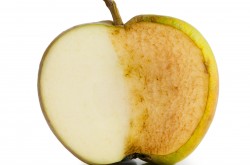3 things you should know about gene editing to cure disease, how biofuels can reduce aircraft carbon emissions, and the potential for robots to replace farm tractors

Meet Renée-Claude Goulet, Cassandra Marion, and Michelle Campbell Mekarski.
They are Ingenium’s science advisors, providing expert scientific advice on key subjects relating to the Canada Agriculture and Food Museum, the Canada Aviation and Space Museum, and the Canada Science and Technology Museum.
In this colourful monthly blog series, Ingenium’s science advisors offer up three quirky nuggets related to their areas of expertise. For the January edition, they provide context around the latest developments in a genetic treatment for sickle cell disease, how sustainable aviation fuels reduce carbon dioxide emissions, and how autonomous robots may someday replace traditional farm tractors.
The future of farming includes help from robots
Autonomous robots have made their entrance into the agricultural world, and could help increase farm profitability, productivity, and sustainability, as well as mental and physical health of farmers. In fact, applying existing robotics and machine learning technologies to farming may help solve some challenges agriculture is facing today. But this is easier said than done.

An example of an autonomous tractor, working in the field
Farming is not easy. The impacts of farm machinery and chemicals on the environment and on farm soils are more widely recognized than ever before. In response, farmers are seeking ways to apply fertilizer and pesticides more precisely, and reduce field travel, which can damage soil and render it less productive. On the human side, farming is also known as a way of life; it is physically and mentally demanding, high risk (working around machines daily), and includes long hours. And finally, the industry is facing a real human resources crisis given the number of farm owners and operators is dwindling, and fewer people are willing to take on farm work, which is often seasonal and lower-paying. Robots can help with all that.
There have been several barriers to overcome in transferring advanced technology from the manufacturing, military, and space exploration sectors to agriculture. First off, the farming environment and the tasks it demands from robots are totally different from what robots have been asked to do before. Farming mainly happens outdoors, is messy, deals with living things and with the weather, and most of all it must adapt to constantly changing conditions. Add to this that no two farms are the same, and no two farmers farm the same way. The robots we have are just not really equipped to deal with what farming will throw their way. For the most part, they are great at specific tasks, in clean and controlled environments, where they are contained to a certain limited space and are easy to access for upkeep and repairs.
The places where we are most likely to find ag robotics right now are greenhouses because these environments most closely resemble those that existing autonomous robots were developed for. On more and more dairy farms, you’ll find robotic milkers and feed delivery systems that help reduce workload and optimize production. You might also spot some autonomous irrigation systems in fields, and large drones are becoming more common for crop surveillance and fertilizing.
The next frontier is autonomous tractor-like robots for field-work, and some are already available to purchase (see an example here https://korechi.com/farming/). These robots are typically electricity-powered, and use computers, GPS, and sensors to travel the fields. They can weed, apply fertilizer, plant seeds, harvest crops, sample soil, pull other equipment, and do many other tasks – all on their own. They can also learn and optimize, leading to better uses of resources. However, the farm field is probably one of the most variable environments where robots can be used, meaning the technology isn’t perfected yet. This is part of why agriculture is lagging behind in adoption.
The promise of automation doesn't come without its drawbacks. Profit margins in agriculture are small so, unsurprisingly, switching existing human-run machinery to autonomous robots – still new and not widely accepted – presents a huge risk, and is an investment that not everyone is willing to make. There also needs to be in place an ecosystem of experts able to maintain, troubleshoot, repair, and update these computer-run, mechanical systems.
Farm robots may not be a miracle solution to all the challenges farmers face, and they may not be for everyone. But in the right conditions and circumstances, they can take a lot of the guesswork and human hours out of farming, making it more enjoyable, profitable, and environmentally sustainable. Who knows, in time, autonomous robots may replace the tractor, in the same way the tractor replaced the horse.
By Renée-Claude Goulet
Precision Healing: CRISPR's Triumph Over Genetic Diseases
How do you treat a disease that’s literally written into your DNA?
Genetic diseases are health problems caused by abnormalities in your genetic code. They are almost impossible to cure because they are literally written in DNA. Typically, treatment focuses on managing the symptoms rather than fixing the cause. But that might be about to change.

In sickle cell disease, a DNA abnormality causes red blood cells to become rigid and take on a crescent (sickle) shape, blocking small blood vessels and causing decreased blood flow, inflammation, pain, and strokes.
At the end of 2023, a groundbreaking genetic treatment for sickle cell disease was announced. Sickle cell disease affects red blood cells, whose job is to carry oxygen around the body. Red blood cells are usually round, flattened discs – a shape that helps them move easily through our blood steam. However, a single mutation in the DNA results in crescent or sickle-shaped cells which clump together and get stuck in small blood vessels. This limits blood flow, reduces oxygen delivery, and can cause terrible pain, organ damage, strokes, heart attacks, and other issues. In Canada, approximately 5,000 Canadians have sickle cell disease, which can lead to life-threatening disabilities and shorten their lives by more than 30 years.
Until now, the most effective treatment has been bone marrow transplants. Special stem cells in the bone marrow produce red blood cells, and transplanting healthy bone marrow from a donor can generate normal red blood cells. Unfortunately, this is a risky procedure, and there is a significant risk that the recipient’s body will reject the transplant. It’s typically only performed in children, as the risks increase with age. But now, a new gene-editing treatment called Casgevy offers a promising alternative by giving a patient’s bone marrow the ability to produce its own healthy red blood cells.
Here’s how it works: Patients receive chemotherapy to make space for the new cells. Then, doctors take stem cells from the patient's bone marrow and use genetic editing techniques to correct the single DNA mutation. Finally, the edited cells are reintroduced into the patient where they permanently produce healthy red blood cells.
The gene-editing is done using a tool called CRISPR/Cas9, which can be thought of like ultra-precise DNA scissors. Using this tool, scientists can cut DNA in very specific areas, allowing them to accurately edit (remove, add, or replace) DNA where it was cut. It is an incredibly powerful and versatile tool, which earned a Nobel Prize in 2020.
Sickle cell disease is likely to be the first of many genetic diseases that will be treated using this tool. DNA errors are at the root of nearly 7,000 known diseases that could potentially be fixed using CRISPR. The potential impact of this tool is immense, offering hope for many suffering people and marking the beginning of a new era in treatment possibilities.
By Michelle Campbell Mekarski
First trans-Atlantic flight using only sustainable aviation fuel

A white Virgin Atlantic passenger jet in flight with a blue sky and cumulus clouds in the background.
On November 28, 2023, a Boeing 787 passenger jet powered entirely by Sustainable Aviation Fuel (SAF) successfully flew from London, England, to New York City. The Virgin Atlantic flight had no passengers on board as it was meant purely as a demonstration supported by the UK government and private partners to show that it could be done.
Around the world, many industries are trending toward greener technologies in an effort to curb climate change. The aviation industry makes up 3 percent of global carbon emissions, and that number will only grow in time as air travel increases and other industries decarbonize. The global aviation community has committed to taking action and is aiming for net-zero carbon emissions by 2050.
SAF is the most feasible way forward while other technologies are in development. An aircraft using 100 percent SAF will still emit about the same amount of CO2 as it would on regular jet fuel, but its total carbon footprint will be reduced by up to 80 percent! Let’s get into the what, how, and why.
What is Sustainable Aviation Fuel?
Sustainable Aviation Fuel, or SAF (a.k.a. aviation biofuel), is a waste-derived or renewable fuel that has very similar properties to regular jet fuel. SAF feedstock ― a term used to describe the raw source or supply of material ― can be derived from the waste products of different plants, animal fats, cooking oils, or even agricultural or forestry residue. It can also come from dedicated renewable crops planted for the purpose of biofuel.
What makes it sustainable?
The sustainability title is given by meeting a series of requirements: no negative impact on biodiversity or converting use of crops meant for food, no destruction of forests, no overuse or pollution of water, and finally, there must be a reduction in total CO2 emissions.
How does SAF reduce CO2 emissions?
The source of the fuel is the key difference. Combustion of fossil fuels releases carbon into the atmosphere that was previously stored and extracted from reservoirs underground. Sustainable biofuel comes from biomass (plants or animals) that have absorbed CO2 emissions from the atmosphere through its lifecycle. When this fuel is used in an aircraft’s combustion engine, it is returning the absorbed CO2 to the atmosphere, rather than adding to it. Thereby, SAF results in a reduction of the total life cycle of carbon emissions. An added bonus of SAF is clear air, as it also reduces emissions of up to 90 percent particulate matter and 100 percent sulfur.
Why isn’t use of SAF more common?
SAF can be incorporated into existing fuel systems in any aircraft, and fuel blends of up to 50 percent SAF with regular kerosene jet fuel are permitted. However, SAF makes up less than 0.1 percent of jet fuel. The reasons, simply put, are cost and supply scaling. There currently isn’t enough supply of SAF to address even a fraction of the global aviation industry’s demand. A further challenge has to do with the high cost of manufacturing and certifying these fuels.
The green revolution in aviation has begun, but it will take a broad range of support from government legislation, airlines, agriculture, and waste management industries to put SAF into wider production and use.
There are other approaches to reduce emissions in aviation, though each has challenges and limitations. Electric planes are great, but they have a limited range and require large heavy batteries that aren’t suitable to larger aircraft. Hydrogen fueled planes are currently in development, but would require extensive and costly changes in aircraft storage and supporting airport infrastructure.
GO FURTHER:
World’s first 100% SAF flight by the National Research Council Canada in 2012
Canadian Council for Sustainable Aviation Fuel
International Civil Aviation Organization (ICAO)
IATA: International Air Transport Association
By Cassandra Marion
Enjoying the Ingenium Channel? Help us improve your experience with a short survey!







































